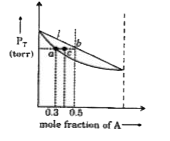For a compound AB which crystallises in CsCl (bcc) lattice with 'a' as the edge length of unit cellSolution in Malayalam
the minimum possible distance between A and A is 'a'
the mean distance between A and B is √3a/2
the density of crystal is given by ρ=2a3MABNA
the minimum distance between B and B is a/2.
The correct Answer is:A, B
In bcc lattice, atoms at the corners (say, A) touch each other. Thus, their distance is equal to the edge length a. the unlike atoms are along the body diagonal of the cube. Their arrangement will be ABA. Thus, the distance between A and B will be √3a/2.
Topper's Solved these Questions
- SOLID STATEBOOK - BRILLIANT PUBLICATIONCHAPTER - SOLID STATEEXERCISE - LEVEL-3 (Matching Column Type)
5 Videos
- SOLID STATEBOOK - BRILLIANT PUBLICATIONCHAPTER - SOLID STATEEXERCISE - LEVEL-3 (Numerical Type)
7 Videos
- SOLID STATEBOOK - BRILLIANT PUBLICATIONCHAPTER - SOLID STATEEXERCISE - LEVEL-3
10 Videos
- REDOX REACTION & ELECTROCHEMISTRYBOOK - BRILLIANT PUBLICATIONCHAPTER - REDOX REACTION & ELECTROCHEMISTRYEXERCISE - QUESTION (ELECTROCHEMISTRY) (LEVEL -II) (ASSERTION-REASON)
3 Videos
- SOLUTIONSBOOK - BRILLIANT PUBLICATIONCHAPTER - SOLUTIONSEXERCISE - Level-III (Linked Comprehension Type)
12 Videos
Similar Questions
Match the crystal systems/unit cells mentioned in Column I with their characteristic features mentioned in Column II.

View SolutionDiamond structure is based on a face centred cubic lattice where four out of the eight tetrahedral holes are occupied by carbon atoms. Every atom in this structure is surrounded tetrahedrally by four other carbon atoms. How many carbon atoms per unit cell in diamond structure ?
View SolutionThe unit cell length of NaCl is observed to be 0.5627 nm by X-ray diffraction studies, the measured density of NaCl is 2.164 g cm−3. Calculate % of missing Na+andCl− ions.
View SolutionAssertion: After the electrolysis of aqueous CuSO4 solution pH decreases.
Reason: Sulphuric acid is formed.
View Solution1 mole of A and 1 mole B are mixed together to form an ideal solution at 25∘C. Solution is placed in a vessel fitted with piston. If pressure on the solution is reduced isothermally.

Correct relationship between P∘AandP∘B is
View SolutionAB crystallises in a bcc lattice with edge length qa equal to 387 pm.The distance between two oppositely chariged ions in the lattice is
View SolutionA compound AB crystallises in bcc lattice with the unit cell edge length of 380 pm. Calculate (i) The distance between oppositely charged ions in the lattice. (ii) radius of B^(-) if he radius of A^(+) is 190 pm.
View SolutionCsCl has bcc arrangement and its unit cell edge length is 400 pm. Calculate the interionic distance in CsCl.
View SolutionA compound AB crystallises in bcc lattice with the unit cell edge length of 380 pm. Calculate (i) the distance between oppositely charged ions in the lattice ,(ii) radius of B^- if the radius of A^+ is 190 pm
View SolutionSodium crystallises in a bcc lattice having unit cell with an edge length of 4.29Å. Calculate the number of unit cells present in 2.3g of Na metal. Determine the number of atoms present in 1 cc of unit cell.
View SolutionIf an atom crystallises in bcc lattice with r = 4Å then the edge length will be-
View SolutionA metal crystallises in bcc lattice structure with unit cell edge of 0.288nm. The density of the metal is 7.8g⋅cm−3. How many unit cells are present in 28g of it-
View SolutionCsCl has BCC structure and its unit cell edge length is 400 pm. Determine the interionic distance in CsCl.
View SolutionA compound AB crystallized in bcc lattice with unit cell edge length of 480 pm. If the radius of B^(-) is 225pm, then the radius of A^(+) is
View SolutionMetallic chromium crystallises in bcc lattice. The edge length of unit cell is 2.87 A_0. Calculate (a) atomic radius and (b) density.
View Solution
